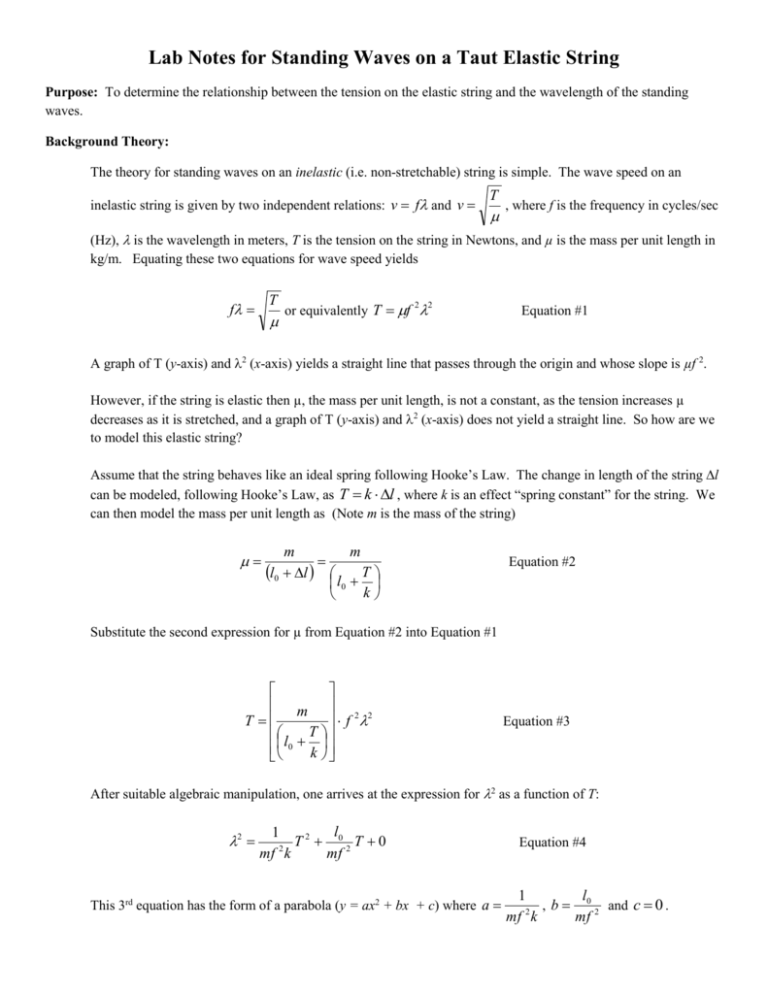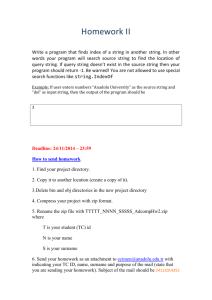Lab Notes for Standing Waves on a Taut Elastic String
advertisement

Lab Notes for Standing Waves on a Taut Elastic String Purpose: To determine the relationship between the tension on the elastic string and the wavelength of the standing waves. Background Theory: The theory for standing waves on an inelastic (i.e. non-stretchable) string is simple. The wave speed on an inelastic string is given by two independent relations: v f and v T , where f is the frequency in cycles/sec (Hz), is the wavelength in meters, T is the tension on the string in Newtons, and µ is the mass per unit length in kg/m. Equating these two equations for wave speed yields T f or equivalently T f 2 2 Equation #1 A graph of T (y-axis) and 2 (x-axis) yields a straight line that passes through the origin and whose slope is µf 2. However, if the string is elastic then µ, the mass per unit length, is not a constant, as the tension increases µ decreases as it is stretched, and a graph of T (y-axis) and 2 (x-axis) does not yield a straight line. So how are we to model this elastic string? Assume that the string behaves like an ideal spring following Hooke’s Law. The change in length of the string l can be modeled, following Hooke’s Law, as T k l , where k is an effect “spring constant” for the string. We can then model the mass per unit length as (Note m is the mass of the string) m m l0 l l T 0 k Equation #2 Substitute the second expression for µ from Equation #2 into Equation #1 m f 2 2 T T l 0 k Equation #3 After suitable algebraic manipulation, one arrives at the expression for 2 as a function of T: 2 l 1 T2 02 T 0 2 mf k mf This 3rd equation has the form of a parabola (y = ax2 + bx + c) where a Equation #4 l 1 , b 0 2 and c 0 . 2 mf k mf This is the model (Equation #4) that you are to test. You will test this model by plotting 2 (y-axis) against T (xaxis) and determining if it is well fit (R2) by a parabola (2nd degree polynomial) with a y-intercept (i.e. c) equal to zero. Additionally, if the model well fits your data, you are to interpret the b coefficient of the parabolic trend line. In particular, since b l0 1 1 , where µ0 is the un-stretched mass per unit length. I have 2 mf m 2 0 f 2 f l0 measured the un-stretched mass per unit length of the white elastic string used in the experiment. It is µ0 = 0.00465 kg/m. Remember the frequency f is 60 Hz. At this time, I am uncertain as to how to interpret the a coefficient. The Lab Write up: due Tuesday, 11 Feb 2014 (Please don’t wait for the 10th of Feb to begin. Do some of the numerical work now while it is fresh.) 1. Title Page 2. Introduction a. State the Purpose b. Discuss in your words the theory behind standing waves on a string, both inelastic and elastic. c. On a separate page (hand-written is OK) fill in the algebraic steps that lead from Equation #3 to Equation #4. (I know that doing the algebra is not comfortable for some of you – that is precisely why I am assigning this task – to build your algebraic skills and confidence.) d. Brief description of the equipment and how you did the experiment (Keep it simple, short, but make it readable.) 3. Display your data (properly labeled and formatted) 4. Display both graphs discussed in the intro. 5. Discuss your results a. Describe the graph of T (y-axis) and 2 (x-axis) and explain why it is non-linear. Relate the slope of the graph to the mass per unit length of the string. b. Describe the graph of 2 (y-axis) against T (x-axis). i. Is it well fit by a parabolic model? How well fit? ii. Is the y-intercept zero as the model demands? If not comment on how different the y-intercept is from zero. iii. Using the b coefficient from the parabolic trend line, derive a value for the un-stretched mass per unit length µ0 and compare it to the value stated previously in this document. iv. Finally, address the purpose by describing the relationship between the tension on the elastic string and the wavelength of the standing waves. If you have trouble – come see me.








